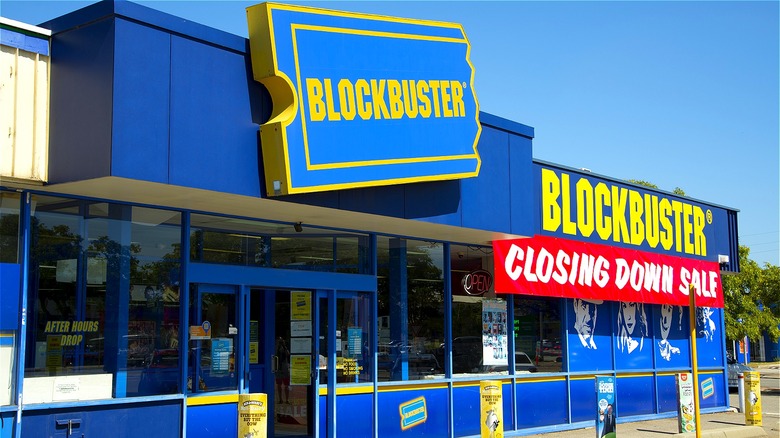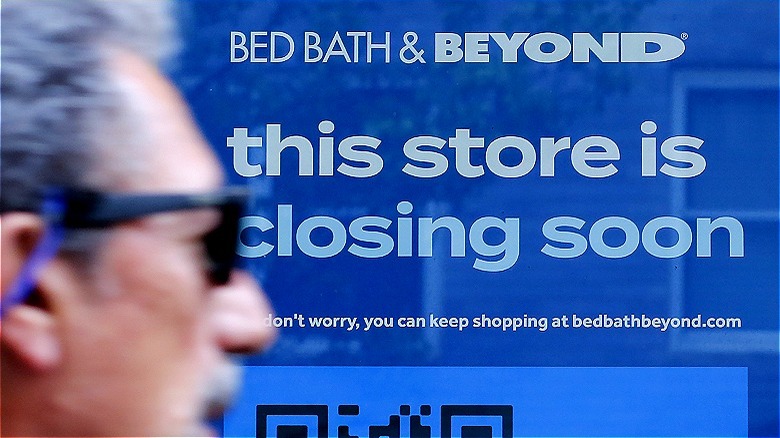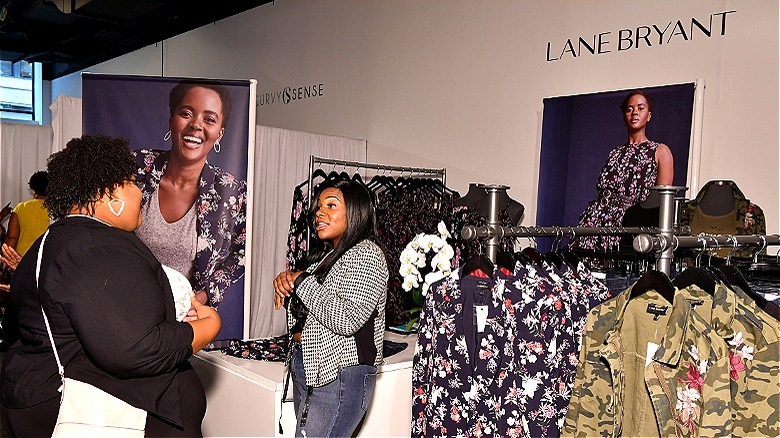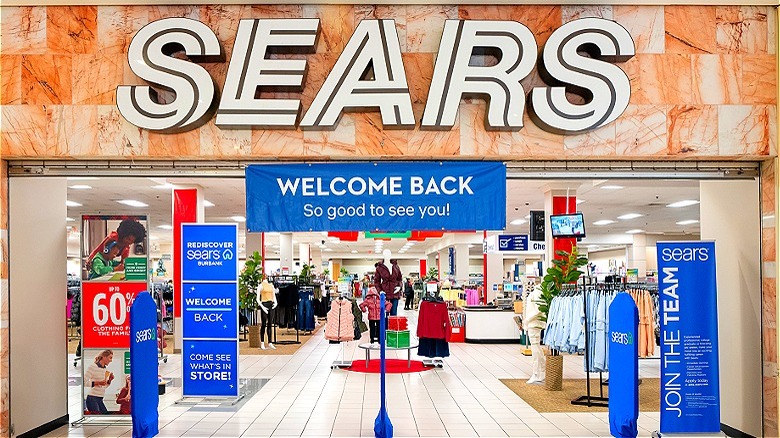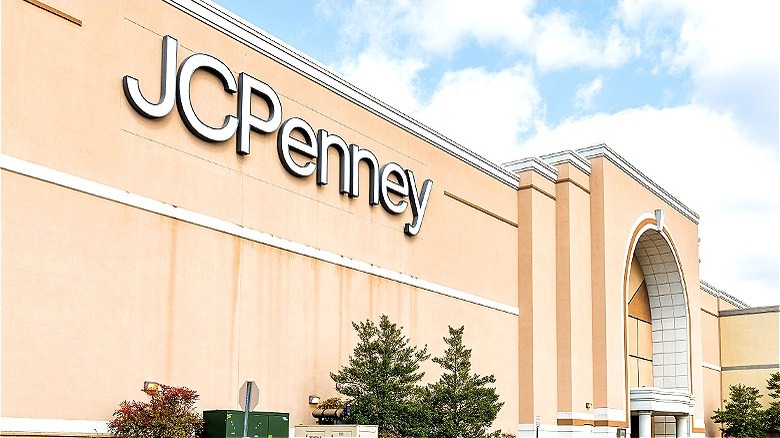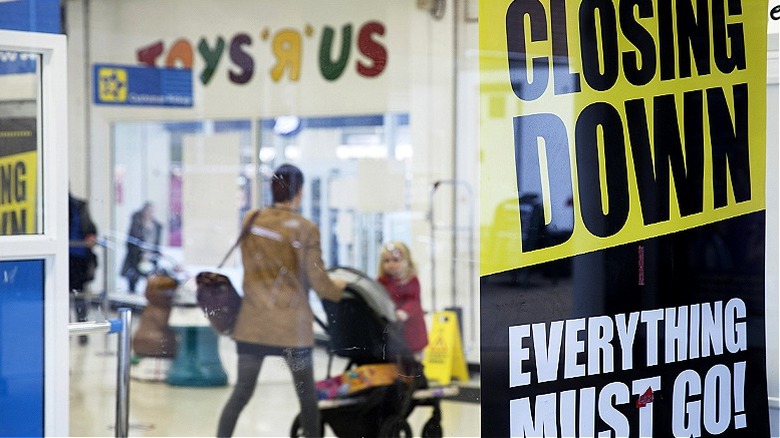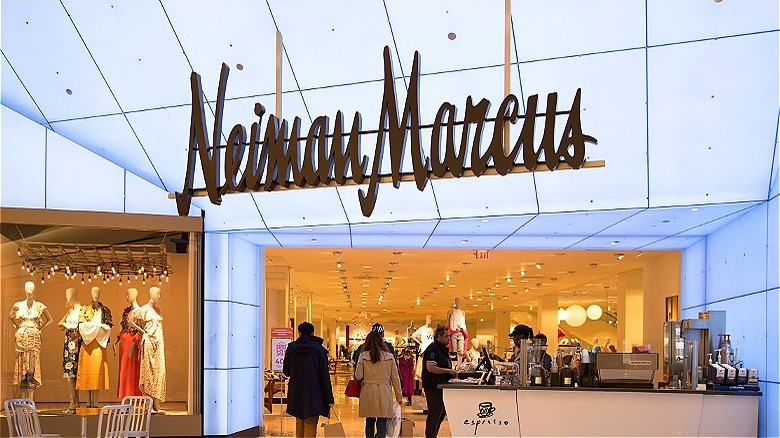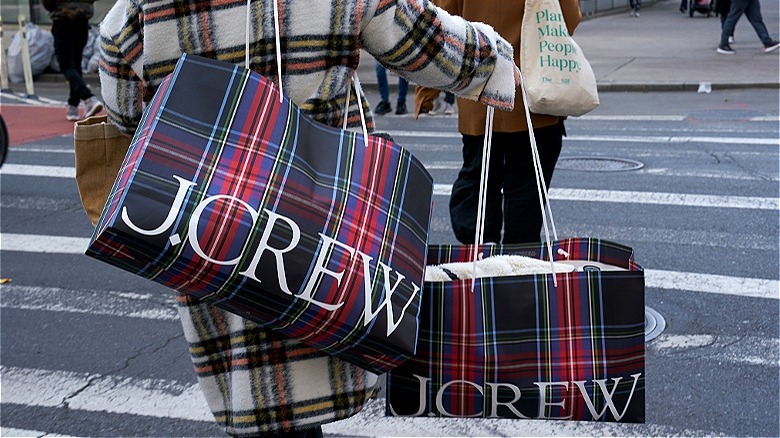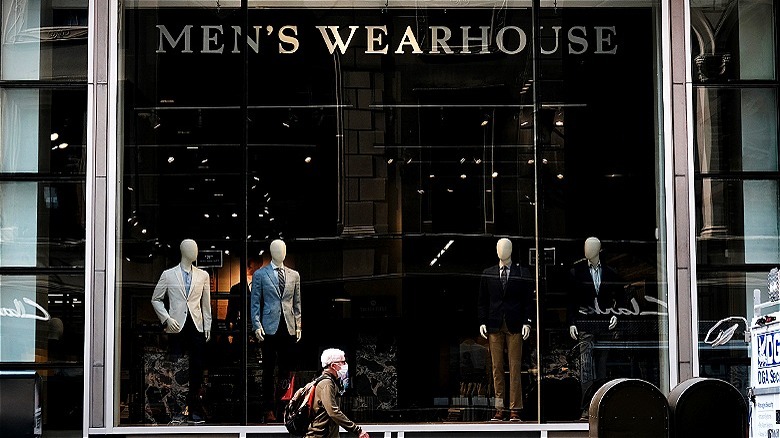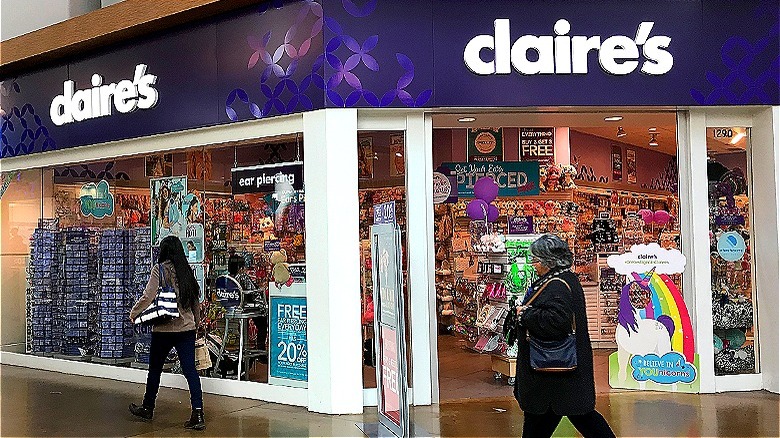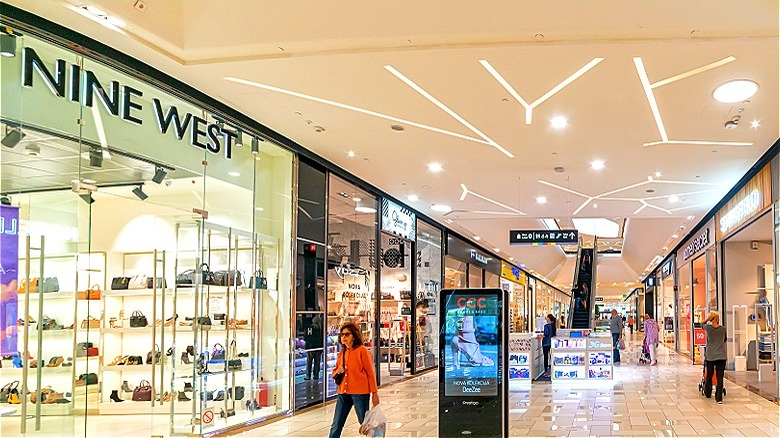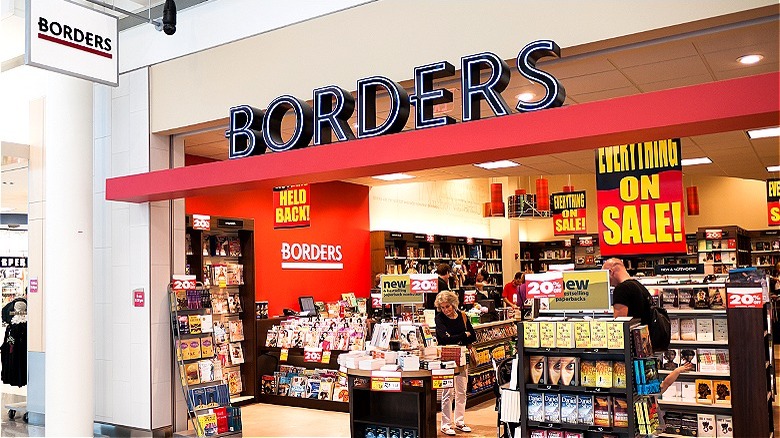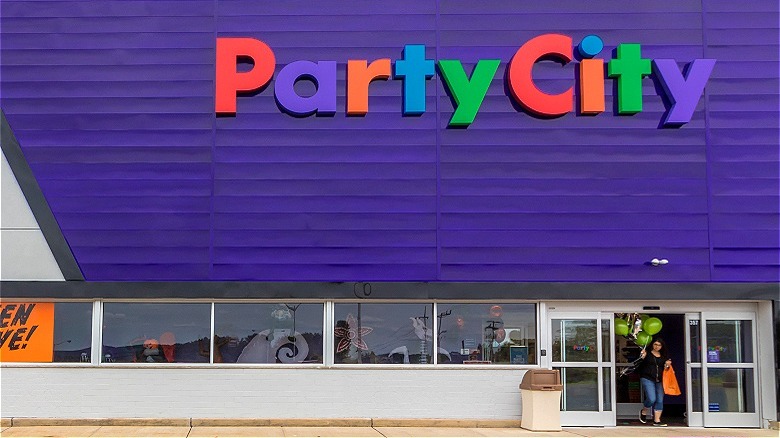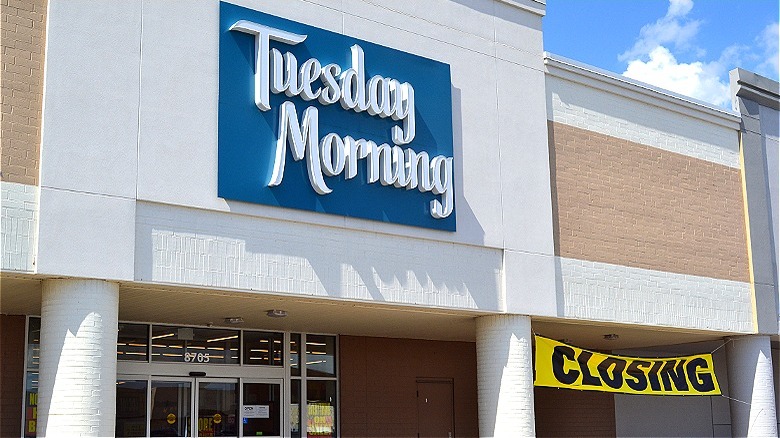Beloved Retail Chains That Filed For Bankruptcy
Over the last three years, several beloved retail brands, such as Sears, J. Crew, and Party City, have filed for bankruptcy. Some of these companies — like Blockbuster back in 2014 — were victims of a technology-driven change in culture. According to CNBC, many of the names appearing on our list are collateral damage from COVID-19 shutdowns, artificially buoyed by government stimulus until the shutdowns ended along with the stimulus funds. Consumer behaviors, meanwhile, influenced by a boost in e-commerce sales during the quarantine, inflationary pressures afterward that kept more working-class dollars in wallets, and higher-income spenders preferring luxury goods over low and midrange retail, also play a part in the bankruptcy equation.
Aside from COVID-19, though, think tank Carnegie Endowment for International Peace explains that a 2019 tariff and trade war between the U.S. and China also impacted the cost of merchandise at the time, with Chinese imports dropping by $44.3 billion in 2019 from the previous year. As for the stimulus money companies received during the pandemic, perhaps as a sign of how much this money may have kept many retail brands on this list afloat, while there were 52 retail bankruptcies in 2020, there were only 21 the following year, per Axios. This said, fallout from the COVID-19 pandemic was also exacerbated by the war between Russia and Ukraine, with tit-for-tat sanctions between the U.S. and Russia causing global supply chain issues.
And so, with that background of the economic situation the retail industry has faced over the past several years, let's take a look now at some specific retail chains, ones that have filed for bankruptcy and how they suffered such a fall from grace.
Bed Bath & Beyond
Per Forbes, as a publicly traded company, Bed Bath & Beyond once boasted a double-digit share price, making it one of the best-performing stocks, slid down to seven cents per share by April 2014. As reported by The New York Times, the company was so broke that it had to borrow $240 million from Sixth Street Specialty Lending — the lending arm of a global investment bank — to continue operating through bankruptcy.
Bed Bath & Beyond's fate is widely believed to be the result of its former CEO Mark Tritton, who was brought on board after activist investors took over the company, and then proceeded to stock the stores with products customers were disinterested in. The Wall Street Journal reported the company borrowed $375 million against a billion dollars in hedge funds to cover its holiday season in 2022 while closing hundreds of outlets. This, after the CFO, Gustavo Arnal, leaped from his 18th-floor balcony after being named in a pump-and-dump scheme to inflate the stock.
The company failed to raise a billion dollars after offering stock options — it raised $360 million — then couldn't raise $300 million on a second try. On April 23, 2023, Bed Bath & Beyond filed for Chapter 11 bankruptcy, which allows companies to restructure their business to stay afloat. Chapter 7 offers companies a chance to sell off their assets to make shareholders and creditors happy. The company tried a version of both. In the end, Overstock.com acquired the company in July 2023 for $21.5 million, and Bed Bath & Beyond today lives on as an online retailer. A decade earlier, Bed Bath & Beyond was valued at $17 billion.
Ascena Retail Group
Ascena Retail Group is the umbrella company that owns known retail brands like Ann Taylor, Lane Bryant, Loft, and Lou & Grey. As per Retail Dive, the sun began setting on the company even before COVID-19 took a chunk of profit away from in-store retailers. While Ascena Retail Group expanded into different lanes, including plus-size and tween wear, by 2019 it was posting an operating loss of $681.4 million. This was a loss of about $590 million more than the previous year.
Already $1.2 billion in debt, the $2.5 billion it cost the parent company to acquire several retail clothiers in the age of e-commerce came back to bite it by the time the pandemic kicked in. Like Bed Bath & Beyond, Ascena also needed to borrow money to try to stay afloat as it closed 2,800 outlets, and used a $230 million line of credit as a lifeline. It didn't help that Ascena's own brands became competitors with each other. Overextended, the company finally filed for Chapter 11 in 2020.
Ascena Retail Group sold Ann Taylor, Loft, Lane Bryant, and Lou & Grey to Sycamore Partners under the umbrella of the Knitwell Group for $540 million as part of restructuring efforts. This time, with an emphasis on distinct versus competing brands.
Sears Holdings Corp
Sears Holding Corp. — a 2005 merger between Kmart and Sears — can blame a bloated corporate structure housing 40 divisions competing for resources, an overcompensated leadership, and the 2008 financial crisis for wiping out 85% of its share value. By 2011, the company was in the red by $11 billion and never had another profitable year afterward.
As reported by CNBC, Sears Holding Corp. filed for Chapter 11 in October 2018, with CEO Eddie Lambert resigning from his position a few days later — with plans to shut down 142 stores within the year. Competition from Walmart's better-targeted, resourced brands, as well as Amazon's supremacy over e-commerce, helped to make the loss-making 140,000-square footage of Sears outlets a losing proposition.
In 2019, Sears Holding Corp. sold its assets to ESL Investments for $5.2 billion, which left it with only 15 full- line stores from the company's former count of 700, per Fox Business. Once the world's largest retailer, with over 3,500 stores and several brands covering houseware, home improvement, and automotive services, the company was sold off piece by piece to the highest bidders.
JCPenney
Per CNN Business, retail chain JCPenney (founded in 1902 by James Cash Penney) had a lock on bargain goods in the United States up until the 2008 Great Recession. During the 1980s and '90s, the rise of other bargain retailers like Walmart and Target began nipping at JCPenney's heels, and the recession and competition dragged its sales down 10% by 2010.
Even with the loss in sales, that would've still left a healthy $18 billion in sales, though. However, JCPenney's controlling investor Bill Ackman switched the CEO for Apple's store head Ron Johnson, who changed the familiar logo, store look, and ads, as well as doing away with coupons and labels recognized by the JCPenney's core market. Johnson resigned in 2013 but not before sales slumped another 25% the previous year. Remaining unprofitable on up to COVID-19 closures in 2020, the company fell into Chapter 11 bankruptcy protection in May 2020 after 118 years in operation.
Simon Property Group Inc. and Brookfield Property Partners LP acquired the ailing retailer and began the process of restructuring JCPenney under new CEO Marc Rosen by selling off around 200 out of 850 stores, updating the look of the remaining stores with a renewed emphasis on its core customer, and paying down $4.5 billion of about $5 billion in debt.
Toys R Us
The chaotic timeline of Toys "R" Us' decline begins in the '90s, around 50 years after the founder Charles Lazarus launched a children's clothing and furniture store named Children's Bargain Town — taking advantage of a post-WWII baby boom — a decade before the store began selling toys and officially changed its name to what we know it as today. According to newsletter Failory, the rise of other big-box chains like Walmart, Kmart, and Costco added intense competition for Toys "R" Us. The internet and online sales also changed the game for the old-school retailer, which attempted to address the latter through a partnership with e-commerce disrupter Amazon. Unfortunately, this partnership may have been the misstep that put the nail in the company's coffin.
The exclusive 10-year commitment of $50 million per year plus a cut of sales to sell Toys "R" Us products probably should have been invested into its own online sales platform. Due to a mounting debt and an e-commerce partnership that began extending to the better-leveraged competitors of Toys "R" Us, by 2005, confidence dropped in the company as quickly as its credit rating. By 2017, kids' interest shifted from toys to tech, and Toys "R" Us found itself $5 billion in debt, with no way to pay the $400 million a year it would take to pay it off in any reasonable amount of time. The company filed for Chapter 11, and by 2021, the company shuttered all of its stores. Toys "R" Us began relaunching stores in 2023.
Neiman Marcus
As covered by The New York Times, Neiman Marcus is a family business and aspirational retail brand that got its start in 1907 alongside the rise of oil tycoons with money to spend on luxury. By 1983, it was rapidly expanding across the nation before being publically traded in 1999. Since then, several private sales led to delisting from the stock market before its debt issues led the company to file for a return to the stock market in hopes of reducing it in 2015. However, the company was overleveraged, and the deal fell through.
The COVID-19 lockdowns, along with the general slowing of the retail market, led to Neiman Marcus filing for Chapter 11 bankruptcy protection in 2020 in hopes of restructuring the company, according to RetailDive. The company was bought by a consortium of investment banks, including PIMCO, Davidson Kempner Capital Management, and Sixth Street, in hopes of eliminating its $4 billion of debt. It succeeded, and by September 2021, Neiman Marcus was out of bankruptcy — although not out of the woods in a market generally unfavorable to retail after the pandemic.
However, rival Saks Fifth Avenue has offered to buy Neiman Marcus out, most recently in a $3 billion deal in late 2023, which the company has again turned down, per The Wall Street Journal. If nothing else, it speaks to a return in confidence for the beloved luxury retailer.
J.Crew Group
J.Crew, the eponymous preppy American lifestyle brand, bears the distinction of being the first national retailer to succumb to pandemic closures and file for Chapter 11 bankruptcy protection in May 2020. The company's liabilities totaled $10 billion at the time of its filing, per CNN, which was about $9 billion more than its assets, and its debt totaled $1.65 billion, which its creditors agreed to convert to equity. J.Crew was also weighed down at the time by its Madewell brand stores — for which an IPO was planned, but never came to fruition due to COVID-19's effect on the markets.
By September 2020, the company was scooped up by the Anchorage Capital Group, was out of bankruptcy, had a new CEO, and was looking ahead. In 2023, J.Crew celebrated 40 years. However, the credit rating agency Standard and Poor downgraded the company to a status of negative from stable in the same year due to inflationary pressures and tighter economic times.
Tailored Brands
Tailored Brands is the parent company of brands Moore's Clothing for Men, Men's Wearhouse, Jos A. Bank, and K&G Fashion Superstore. In August 2020, the company filed for Chapter 11 protection in hopes of lowering its debt by a minimum of $630 million. It planned to close a third of stores and save about $6 million by placing 20% of its corporate roles on the chopping block, as reported by CNN at the time.
According to filing documents submitted to the U.S. Securities and Exchange Commission, the company had eliminated $686 million of debt with a combined $870 million worth of credit and cash committed by financiers. In the filing, Dinesh Lathi, Tailored Brands president and chief executive officer, stated, "Be assured that, while addressing our underlying financial challenges precipitated by the unprecedented impact of COVID-19, we continued to strengthen our business and brands with efforts focused on expanding our omni-channel capabilities to provide even greater convenience for our customers, curating our merchandise assortments to align with today's needs and trends, and launching exciting new partnerships that appeal to existing and new customers."
Just 11 months after exiting bankruptcy, Tailored Brands requested and was granted another $75 million from its lenders in March 2021. Since then, the company has balanced its online sales with store openings under new leadership and a renewed focus on every aspect of menswear including tuxedo rentals.
Claire's
Per Fast Company, Claire's has been an institution for tween and teen customers since its launch back in 1971, growing to 2,500 stores in 17 countries until the mid-aughts. However, as e-commerce affected mall culture — a staple of businesses focused on teen markets — foot traffic dwindled and sales slumped for the Claire's retail brand. By 2018, the writing was on the wall, and the company filed for Chapter 11 bankruptcy while closing 189 of its outlets. By 2022, though, the company made a comeback with $1.4 billion in revenue that took it out of bankruptcy, while its new leadership mulled over a $100 million generating IPO.
By July 2023, the IPO was called off. A public statement from Claire's hinted at other competitors with a larger online sales presence that placed them in an underdog position as a factor. Claire's has done well after its restructuring by leaning into the current love of '90s nostalgia, launching outlets in prestigious malls that continue to have foot traffic, and placing products in stores that already have a ready consumer base. Further, with an older generation now in their 20s, who share a nostalgia for Claire's, the retail brand has also expanded its market to include twenty-somethings.
Nine West Holdings
Nine West Holdings filed for bankruptcy in 2019, becoming another victim of shrinking mall traffic and Amazon-led e-commerce. Bogged down by a billion dollars worth of debt, the company opted to reorganize its assets with the assistance of a $300 million line of credit. As per Reuters, the company exited bankruptcy in March of 2019 — almost a year to the day it filed for Chapter 11 — although, it didn't leave unscathed. The company sold its Nine West and Bandolino businesses in a court-ordered auction for $340 million to Authentic Brands Group and changed its name to Premier Brands Group Holdings LLC; however, it managed to hold onto its One Jeanswear, Jewelry, and Kasper Group. It initially held onto its Anne Klein businesses until selling it to WHP Global.
According to Fashion Network, Forever 21 partnered with Premier Brands Group Holdings LLC in 2023 on a limited-edition run of women's shoes priced for affordability rather than luxury. Ironically, Forever 21 was also rescued from bankruptcy by Authentic Brands Group, too.
Borders
Borders, the beloved bookstore with hundreds of outlets across the United States, met its end for a few reasons. As explained by Slate, one reason was Borders' slow adoption of e-reader platforms and internet sales in general. Another, however, was a bad deal with Amazon that leveraged all its online book sales through the behemoth middleman instead of its own website.
With a product line that still relied heavily on DVD and CD sales into the mid-2000s, as music, TV, and movie streaming soared, Borders simply wasn't ready for a world of Kindle, Netflix, and iTunes. With $1.29 billion in debt, the company filed for bankruptcy and Chapter 11 protection in February 2011. It got so bad for Borders, publishers stopped sending the store books since the company had stopped paying the publishers for them.
Unlike several of the companies on our list or beloved retail brands, Borders was in too deep and was too far behind to save itself in the end. In the end, almost 11,000 jobs folded under the weight of 400 store closures in the shadow of a business that hadn't posted a profitable year since 2006.
Party City
Party City entered into bankruptcy in January 2023 with $1.7 billion in debt, as reported by CNN. Party favors and costumes weren't big enough sellers for the chain that had suffered losses over the previous three years. Even as Party City managed to keep most of its 800 stores in the U.S. open by renegotiating leases to secure jobs for thousands of employees, Chapter 11 couldn't keep Party City's stock from becoming one of the worst-performing stocks of 2023. It probably didn't help that all its remaining stock was erased as part of the agreement and none of its investors were reimbursed.
Per RetailDive, after reducing $1 billion of debt, Party City clawed its way out of bankruptcy in October 2023 with $637 million in credit and cash, surviving through supply chain issues, pandemic closures, and cancellations. Considering that Party City once stood over a precipice, it's impressive that it not only pulled itself off of the edge but managed to hold on to all its store locations.
Tuesday Morning
Tuesday Morning is a company that should've at some point asked itself, what is a budget? In May 2020, the discount chain store filed for Chapter 11 after COVID shutdowns had a major impact on its bottom line sales, forcing the company to shed nearly 33% of its outlets (230 out of 700) where there was an oversaturation of stores. It makes sense under the circumstances. However, the company filed for Chapter 11 bankruptcy protection a second time in February 2023, still attempting to manage its debt and reorganize its operations.
As reported by RetailDive, Tuesday Morning's second bankruptcy filing included a plan to auction off 250 more store locations and a $51.5 million agreement with Invictus Global Management to keep the company afloat through the process. Unfortunately, U.S. Bankruptcy Court Judge Edward Morris decided to put the company out of its misery, overruling Invictus' overtures to finance the struggling company. Instead, the court approved a final sale to Hilco Merchant Resources for $32 million, spelling the end of Tuesday Morning, a move to Chapter 7 for liquidation of assets, and a $34.5 million settlement of the company's debts.
